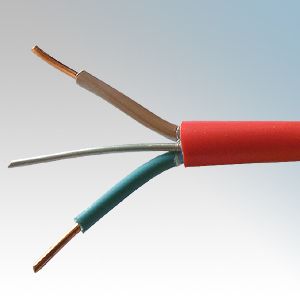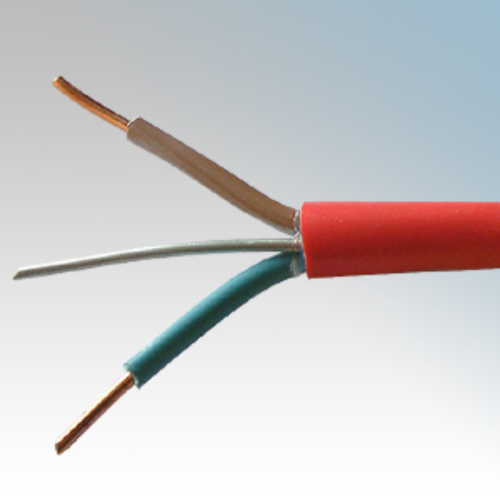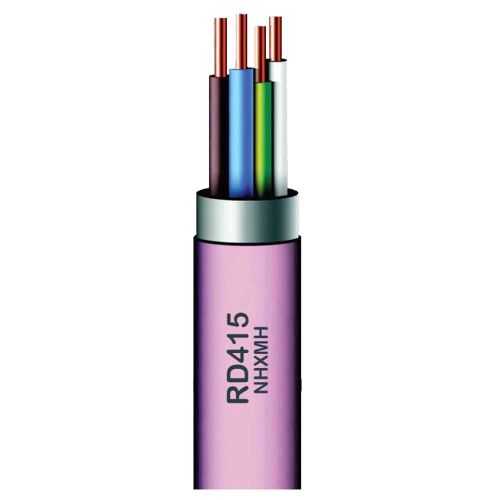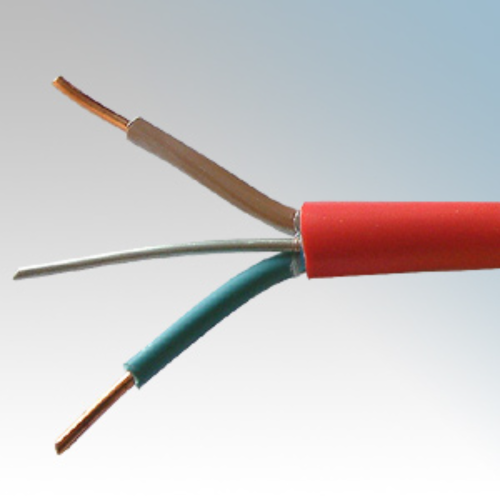Fire Resistant Cable
Fire retardant cables are designed for applications where the power supply has to be secure in emergency situations such as a fire. Fireproof cables allows emergency systems within a building to continue to function in severe fire conditions. These emergency systems include fire alarms, fire detections, emergency lighting systems and voice alarm systems.
What is Fire proof cable?
Fire alarm cable has a plain annealed conductor, this can be multi core and has a low smoke zero halogen insulation with MICA fire retardant tape. All our fire cable conforms to BS EN50200 class PH60. It meets approvals LPCB to BS5839-1, BASEC to BS7629 and BS6387 CNZ, BASEC and LPCB approval to BS EN ISO 9001:20007.
What is PH60?
PH60 fire resistant cable means that this cable will remain operational for up to 60 minutes under fire conditions. BS7629-1,BS EN50200 PH60 fireproof cable is the basic type of cable required for standard fire alarm and emergency lighting systems.
Please browse and order online today for next day delivery, more sizes are available upon request.
What Is A Fire Resistant Cable?
Manufacturers created fire and heat resistant cables to secure the power supply in emergencies. The most important fire resistant cable application is when a fire breaks out.
There is a high risk of fire-related accidents in any location with many wiring mechanisms. To avoid major power failures, power plants use a fireproof cable.
If a building experiences a fire-related accident, fire resistant cables make it possible for emergency systems to function, ensuring everyone’s safety. Fire resistant cables are used to power emergency systems such as fire alarms, emergency lighting systems, fire detection systems and voice alarms systems.
Most manufacturers create fire resistant cables with non-flammable isolated mica tape wrapped around copper wires to protect from a fire. Typically, regular cables emit smoke which greatly hinders emergency efforts.
However, with fire resistant cables, you don’t have to worry about this issue. Fireproof cables are halogen-free, unline regular cables, which means they don’t emit smoke that ruins emergency procedures.
To provide the best possible usage, fire resistant cables should meet EN50200 class PH60 requirements. At Meteor Electrical, you can find fire proof cables that meet LPCB to BS5839-1, BASEC to BS7629 and BS6387 CNZ, BASEC and LPCB requirements.
What Is The Function Of Fire Resistant Cables?
The main function of fire resistant cables is providing power during emergencies such as a fire breakout. A solid fire resistant cable does not immediately shut off in the event of a fire. Instead, these cables keep providing power to travel through circuits.
This power is directed towards emergency systems such as elevators, fire pumps, smoke control equipment and fire alarm systems.
Most safety protocols require that emergency circuits stay operational for 2 hours during an emergency. Fire resistant cables should operate for 2 hours because they:
- Give people time to evacuate the building
- Firefighters use their equipment to put out the fire
- Effectively communicate during an emergency
A fire or heat resistant cable must allow enough time to carry out these procedures. If your fire resistant cable fails to provide this time frame, you must consider a better option of cables.
What Are The Components Of Fire Resistant Cables?
There are six main components in fire resistant cables. These include:
- The conductor - in most fire rated cables, the conductor is made of annealed plain copper, which provides high conductivity. This conductor is the main component that supplies power from fire rated cables. Copper has a melting point of 1083 degrees Celsius, making it a good cable conductor and fire resistant cable material.
- The heat barrier - just underneath the conductor is the heat barrier. This barrier is shaped like a ring, and manufacturers fit this cylindrical component around the conductor. The heat barrier is the first line of defence in fire-rated cables and is usually made from high-temperature sustaining tape.
- The Insulation - The insulation is the next line of defence after the heat barrier. The insulation is made of fire-resistant cross-linked polyethene in fire-rated cables. This material further protects your cables from fire and keeps them running for a long time.
- The inner sheath - The internal sheath component is important for reducing smoke emissions during fire breakouts. In fire rated cables, the inner sheath is made of a zero halogen and low smoke compound for little to no gas emissions.
- The armour - In a fire proof cable, the armour component is created with galvanised steel.
- The outer sheath - Similar to the inner sheath, the outer sheath of a fire proof cable also contains a halogen and low smoke compound.
What Is The Classification Of Flame Resistant Cables?
Most flame resistant cables are divided into Class A and Class B. Here is a detailed look at both these distinctions.
Class A Flame resistant cables
Class A flame resistant cables are high-performing fireproof cables that work well in extraordinary fire breakout situations. These fire proof cables can stand temperatures between 950 degrees to 1000 degrees celsius.
Class A flame resistant cables will withstand all damage and burning for up to 90 minutes, and there is no risk of the cable puncturing.
This time frame will give people plenty of space to make necessary emergency arrangements. This is why you must use Class A flame resistant cables if you want to maintain your emergency power supply for longer.
Class B Flame Resistant Cables
Class B flame resistant cables slightly underperform compared to class A flame resistant cables. Still, they provide enough protection for your power supply to keep your emergency systems running in the event of a fire breakout.
Manufacturers create class B fire proof cables to withstand temperatures between 750 degrees to 800 degrees celsius. Even though this is a slight temperature resistance drop from Class A fire proof cables, there is still enough protection to give you ample time for emergency procedures.
Just like the Class A fireproof cables, the Class B cables also avoid burning and damage for up to 90 minutes. However, some electricians have reported problems with the refractory layer in these cables. Manufacturers heard these complaints and have made major progress in improving Class B cable components.
What Are The Best Materials For Fire Resistant Cables?
Suppose you are looking for the best type of fire resistant cable materials. In that case, you should purchase fire resistant cables with mineral insulation as this material performs much better than fire resistant cables made of copper core, copper sheath and magnesium oxide insulation.
To get the most long-lasting fire rated cables, you should consider purchasing MI cables. MI stands for mineral insulated cables, and this material offers the best fire resistance characteristics. MI fire rated cables offer high-performing fire resistance, and these cables operate over temperatures of 250 degrees Celsius.
What Cable Fire Resistant Specification Should You Consider?
Since there are various fireproof cables, it's difficult to know which specifications are cable fire resistant. Here is a list of essential cable fire resistant specifications to help you make informed purchases. These specifications evaluate the long-term temperature resistance because you want cables that work well in high-temperature conditions.
The best cable fire resistant specifications are:
- The resistant vinyl polyfluoroethylene insulation and sheath should withstand temperatures between 70 and 105 degrees celsius. For cross-linked polyethene insulation, the temperature resistance must be 90 degrees Celcius.
- The temperature resistance must be 220 and 260 degrees celsius for fluoroplastic insulation and sheathing.
- For Fluoroplastic insulation and flame retardant polyvinyl fluoride sheathing, the temperature resistance must be between 90 and 125 degrees celsius.
- For low-halogen and low-smoke flame insulation and sheathing, the temperature resistance must be 70 degrees celsius. If you use fully halogen-free, low-smoke insulation and sheathing, the temperature resistance should be between 90 degrees Celcius and 125 degrees Celcius.
There is a certain specification for cable fire resistance in minimal ambient temperatures. These cables must obtain a safe laying temperature that must not drop below 0 degrees Celcius.
Additionally, the best fireproof cables should operate between 60 to 90 minutes at a minimum. Meteor electrical has an excellent selection of fire resistant cables that remain operational for over 60 minutes.
What Are The Types Of Fire Resistant Cables?
There are two main fireproof cables: MI cables and MC cables. Here are a few things you should consider before purchasing these fireproof cables.
Mineral Insulated (MI) Fire Proof Cables
As previously mentioned, MI fire proof cables have some of the best materials to withstand fire breakouts. Manufacturers produced these fire resistant cables in 1896, which means that these cables are reliable and a great option for fireproof wiring.
MI fireproof cables either have a single or multiconductor design and are created with solid copper and magnesium oxide. Since copper has a high melting, it is the best component for fire resistance cables. MI fire rated cables agave UL 2196 testing approvals and a great overall reputation.
If you work in power plants with an increased risk of explosion and large fire disasters, you should consider using MI fire rated cables for better performance and security. MI fire rated cables are explosion-proof, and they offer strong corrosion resistance.
MI fire rated cables also provide a high flow rate and current carrying capacity, which means that in case of a fire, your power supply flow won’t diminish greatly, and it will stay the same as before the fire incident.
In fire-related emergency evacuations, you need clear paths so everyone can take necessary safety precautions without damaging their health. MI fire rated cables provide high radiation resistance, so there is no harmful gas generated from cable burning.
Even if your cable experience burns damage, no toxic gases will come from MI fire rated cables as they don’t have a zero-halogen compound. Other benefits of an MI fire rated cable include high mechanical strength, lightweight, small size, long-lasting and smokeless capabilities.
MI fire rated cables also include a metal cover that shields the wires from the damaging effects of oxidation. This feature is crucial for wet locations or chemical usage. MI fire rated cables won’t corrode, which minimises the likelihood of replacing these fire resistant cables. This promotes safety in areas, like nuclear plants, where the job of replacing fire rated cables is extremely dangerous.
Most MI fire-rated cables have a high price, making them less desirable for budget-conscious suppliers. However, there are a few limitations of MI fire rated cables. The installation process with MI fire rated cables is complicated compared to other fire resistant cables.
If you want to install MI cables in an oil irrigation area, you might experience difficult construction. Wooden buildings are not a suitable installation location for MI fire rated cables.
However, the benefits of an MI fire rated cable sometimes outweigh the limitations. Think of how these cables will benefit your emergency systems before purchasing MI fire rated cables.
Metal-Clad (MC) Fire Proof Cables
Metal-Clad fire rated cables are another common type of cable. There are different types of MC cables, but most are manufactured with three insulated wires. The insulated wires are shielded by aluminium. There are three common MC cable sizes - 10 gauge, 12 gauge and 14 gauge.
There are several benefits of MC fire rated cables. Compared to MI cables, these cables are much safer and easier to work with. MC cables are less expensive compared to MI cables, and there aren’t high installation costs with this cable type.
MC fire rated cables are easier to install because they are flexible. Another great benefit of MC cables is that they have a 2-hour fire rating, which means you get enough time to implement safety procedures if a fire breaks out.
What Is The Difference Between Flame Retardant vs Fire Resistant Cables?
If you are considering different fire resistant cables, you might think, what’s the difference between flame retardant vs fire resistant cables? Despite similar names, there are major differences between flame retardant vs fire resistant cables, and they should not be used interchangeably.
To understand the differences between flame retardant vs fire resistant cables, you must look at the characteristics of these products. Since fire resistant cables have already been discussed, here are the important elements of flame retardant cables.
Flame Retardant Cables
A flame retardant cable is a cable that extinguishes the residual flame or residual burns by itself. The process happens in a limited time if the cable sample is burned under specific conditions. If a flame retardant cable catches on fire, the flame only spreads within a narrow range.
When it comes to structural differences between flame retardant vs fire resistant cables, there is no major difference as it looks similar to ordinary cables.
The only key difference is that all or some sections of flame retardant cables are made using flame retardant materials. Some components with flame retardant materials include the insulating layers, outer sheath and auxiliary materials.
What Is The Key Difference Between Flame Retardant vs Fire Resistant Cables?
The key difference between flame retardant cables bs fire resistant cables is how they operate in a fire breakout. Fire resistant cables maintain a normal power supply for over 60 minutes in a fire breakout; however, flame retardant cables do not have this feature.
Even though fire retardant cables do not supply power during a fire breakout, they remain undamaged in this situation. If you want your wiring to stay safe, you should go for fire retardant cables, but if you want a power supply during a fire breakout, you must use fire resistant cables.
Since fire resistant cables provide a normal power supply during emergencies, they are the best choice for modern cities and industrial buildings. This cable is a good choice because it supplies power to control, monitor and guide alarm systems.
Fire resistant cables also work well in power supply circuits. Even though flame retardant cables do not provide energy in fire breakout, they prevent the spread of flames to other equipment. This feature helps prevent other greater losses.
If you want to install cables in a chemical company, you will greatly benefit from flame retardant cable. Flame retardant cables have low halogen compounds and low smoke flame retardants, making them a better choice for chemical companies.
These compounds are important as they do not generate harmful gasses in case of a fire. Since there is also smoke from the flames, it is best to avoid cables that will add to this smoke.
What Are The Best Fire Resistant Cables On The Market?
Since there are wide varieties of fire resistant cables, it’s difficult to know which cables are the best. Here is a list of the three best fire rated cables on the market right now. You can avail these fire resistant cables at Meteor Electrical.
-
SWA Firesafe Cable
The SWA firesafe cable is one of the market's best fire-rated cables. SWA firesafe cables maintain the integrity of your main power circuit and withstand any fire damage. SWA firesafe cable was designed by manufacturers for fire safety installation.
SWA firesafe cables are installed in various locations such as schools, hospitals, cinemas, department stores, hotels etc.
SWA firesafe cables met the requirements set by British Standard BS7846. SWA firesafe cables are made with mica tape barrier conductors, and cross-linked polymer insulated cores overlaid with LSZH bedding. The cables have a single steel wire armoured, and LSZH sheathed.
-
Detector Cable
Detector cable is another great fire-resistant cable best used for residential buildings. This cable works well with residential smoke, heat and carbon monoxide detectors.
The detector cable complies with ETCI regulations as it contains the core colours of brown, blue, green/yellow and white. This cable has a pink sleeve, making it stand out from other colours.
-
2 Core+Earth Red Fire Resistant Cable
This state-of-the-art resistant cable is a robust 100-meter cable reel that provides an excellent power supply during a fire breakout. This fire resistant cable has a flexible design which makes installation very easy.
FAQ's
- What is difference between FR and FRLS cable?
- What is the difference between flame resistive cables and flame retardant cables?
- What is LSF cable?
- Is LSF cable a requirement?




